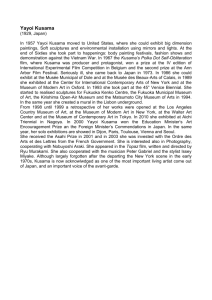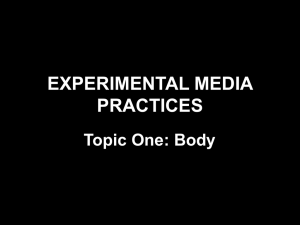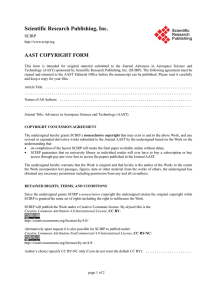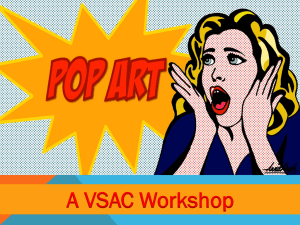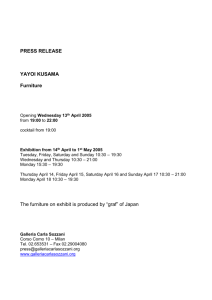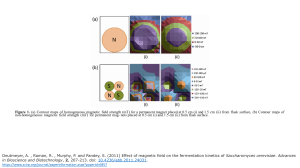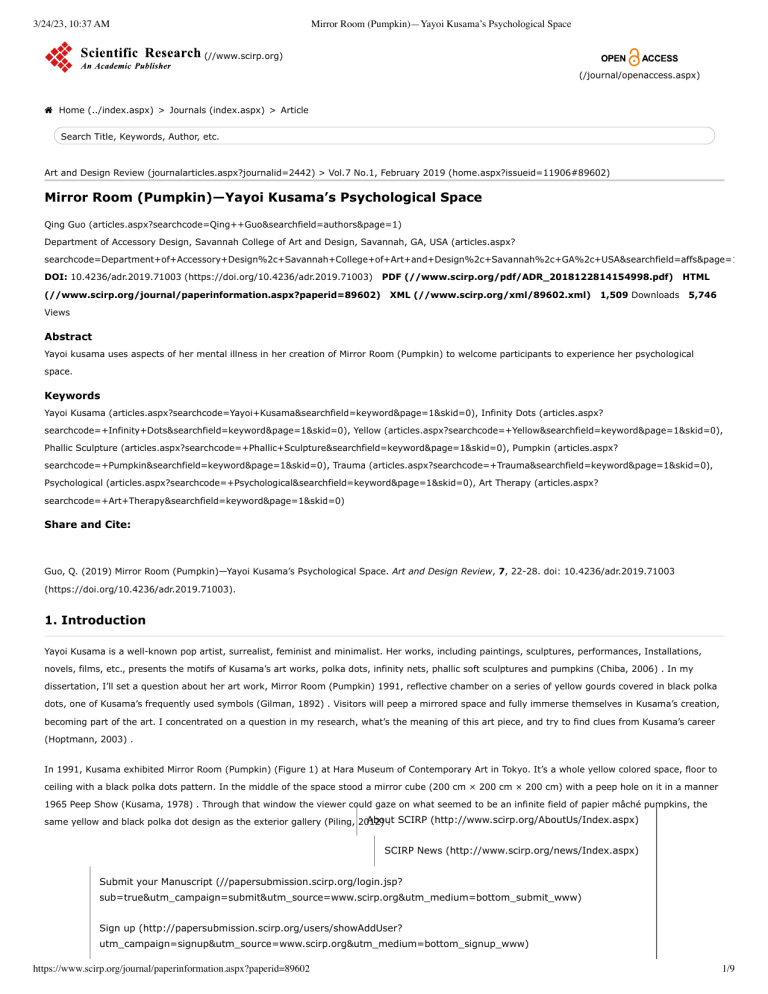
3/24/23, 10:37 AM Mirror Room (Pumpkin)—Yayoi Kusama’s Psychological Space (//www.scirp.org) (/journal/openaccess.aspx) Home (../index.aspx) > Journals (index.aspx) > Article Search Title, Keywords, Author, etc. Art and Design Review (journalarticles.aspx?journalid=2442) > Vol.7 No.1, February 2019 (home.aspx?issueid=11906#89602) Mirror Room (Pumpkin)—Yayoi Kusama’s Psychological Space Qing Guo (articles.aspx?searchcode=Qing++Guo&searchfield=authors&page=1) Department of Accessory Design, Savannah College of Art and Design, Savannah, GA, USA (articles.aspx? searchcode=Department+of+Accessory+Design%2c+Savannah+College+of+Art+and+Design%2c+Savannah%2c+GA%2c+USA&searchfield=affs&page=1 DOI: 10.4236/adr.2019.71003 (https://doi.org/10.4236/adr.2019.71003) (//www.scirp.org/journal/paperinformation.aspx?paperid=89602) PDF (//www.scirp.org/pdf/ADR_2018122814154998.pdf) XML (//www.scirp.org/xml/89602.xml) 1,509 Downloads HTML 5,746 Views Abstract Yayoi kusama uses aspects of her mental illness in her creation of Mirror Room (Pumpkin) to welcome participants to experience her psychological space. Keywords Yayoi Kusama (articles.aspx?searchcode=Yayoi+Kusama&searchfield=keyword&page=1&skid=0), Infinity Dots (articles.aspx? searchcode=+Infinity+Dots&searchfield=keyword&page=1&skid=0), Yellow (articles.aspx?searchcode=+Yellow&searchfield=keyword&page=1&skid=0), Phallic Sculpture (articles.aspx?searchcode=+Phallic+Sculpture&searchfield=keyword&page=1&skid=0), Pumpkin (articles.aspx? searchcode=+Pumpkin&searchfield=keyword&page=1&skid=0), Trauma (articles.aspx?searchcode=+Trauma&searchfield=keyword&page=1&skid=0), Psychological (articles.aspx?searchcode=+Psychological&searchfield=keyword&page=1&skid=0), Art Therapy (articles.aspx? searchcode=+Art+Therapy&searchfield=keyword&page=1&skid=0) Share and Cite: Guo, Q. (2019) Mirror Room (Pumpkin)—Yayoi Kusama’s Psychological Space. Art and Design Review, 7, 22-28. doi: 10.4236/adr.2019.71003 (https://doi.org/10.4236/adr.2019.71003). 1. Introduction Yayoi Kusama is a well-known pop artist, surrealist, feminist and minimalist. Her works, including paintings, sculptures, performances, Installations, novels, films, etc., presents the motifs of Kusama’s art works, polka dots, infinity nets, phallic soft sculptures and pumpkins (Chiba, 2006) . In my dissertation, I’ll set a question about her art work, Mirror Room (Pumpkin) 1991, reflective chamber on a series of yellow gourds covered in black polka dots, one of Kusama’s frequently used symbols (Gilman, 1892) . Visitors will peep a mirrored space and fully immerse themselves in Kusama’s creation, becoming part of the art. I concentrated on a question in my research, what’s the meaning of this art piece, and try to find clues from Kusama’s career (Hoptmann, 2003) . In 1991, Kusama exhibited Mirror Room (Pumpkin) (Figure 1) at Hara Museum of Contemporary Art in Tokyo. It’s a whole yellow colored space, floor to ceiling with a black polka dots pattern. In the middle of the space stood a mirror cube (200 cm × 200 cm × 200 cm) with a peep hole on it in a manner 1965 Peep Show (Kusama, 1978) . Through that window the viewer could gaze on what seemed to be an infinite field of papier mâché pumpkins, the About same yellow and black polka dot design as the exterior gallery (Piling, 2012) . SCIRP (http://www.scirp.org/AboutUs/Index.aspx) SCIRP News (http://www.scirp.org/news/Index.aspx) Submit your Manuscript (//papersubmission.scirp.org/login.jsp? sub=true&utm_campaign=submit&utm_source=www.scirp.org&utm_medium=bottom_submit_www) Sign up (http://papersubmission.scirp.org/users/showAddUser? utm_campaign=signup&utm_source=www.scirp.org&utm_medium=bottom_signup_www) https://www.scirp.org/journal/paperinformation.aspx?paperid=89602 1/9 3/24/23, 10:37 AM Mirror Room (Pumpkin)—Yayoi Kusama’s Psychological Space Figure 1. Mirror Room (Pumpkin) 1991, mirror, iron, wood, plaster, styrofoam, acrylic, 200 cm × 200 cm × 200 cm, Hara Museum of Contemporary Art, Tokyo. In this pumpkin work, Kusama nearly shows all her iconic traits: yellow color with black dots, pumpkins, and an infinity made by the mirror. Kusama has traced the origins of these motifs back to hallucinations that first struck when she was ten years old. Dr. Nishimura, a psychiatric physician, diagnosed as “atypical psychosis”, which resulted in schizophrenia and irritability (Kusama, 2002). Kusama’s mental disease comes from her “Childhood trauma”. An upper-middle-class family of seedling merchants, it seemed that little Kusama had a good family. However, Kusama’s father was a playboy, continually have sexual relationship with whores, geishas, even housemaids one after another. Kusama’s mother was the proud daughter of the head of the family and owner of bad temper (Kusama, 2011) . She became hysterical when her husband left for trysts, and forced young Kusama to follow him and report back. after Kusama’s reports, her mother would vent all her rage on little Kusama, and would send her again next time. That may be the reason why Kusama kept a platonic relationship for ten years with her lover, Joseph Cornell, a famous American contemporary artist. It is said that they don’t have sex in their relationship. Thus, I get the first clue; Kusama had tremendous fear of sex. In this awful family atmosphere, the only thing that kept her in peace was drawing. However, her mother had a strong opposition to Kusama’s art pursuits (Takako, 2008) . In conservative Japanese families, girls who pursue art are considered shameful. Kusama’s mother wanted Kusama to be like a art dealer rather than artist. She always kicked Kusama’s palettes, ripped up her works and threw them away. The earliest recorded work, the image of her mother in a kimono (Figure 2), is covered and obliterated by dots, looks sad and depressing (Yayoi, 2016) . It is not like a portrait of a mother, but an expression of hate and anger. During World War Ⅱ, Kusama decided to escape from that toxic family. She wrote letter to Georgia O’keefe, O’Keeffe has been recognized as the “Mother of American modernism”. Kusama expressed her willing to go to American and received advice from her on visiting the US and conducing artistic activities there. So, in 1957, Kusama moved to New York to start her art career. Before she went to America, her mother gave Kusama a sum of cash About SCIRP (http://www.scirp.org/AboutUs/Index.aspx) and told Kusama never to come back. when she left, she burned down thousands of works on the river bank outside her home, expressing her anger at her mother. It was a way to eliminate the memories of past (Young, 2010) . SCIRP News (http://www.scirp.org/news/Index.aspx) Kusama formally started her art career after arriving in New York in 1957, and her enormous productivity was also during her first years after her arrival Submit your Manuscript (//papersubmission.scirp.org/login.jsp? in New York. She continually drew white circles on a huge black canvas, after it’s done, the paining was seemed like numerous black dots on a white sub=true&utm_campaign=submit&utm_source=www.scirp.org&utm_medium=bottom_submit_www) background. Kusama repeated this kind of works again and again. Reproducing the objects again and again, was her own way of conquering the fear. It was a kind ofSign self-therapy. Infinity net (1959), is the debut of Yayoi Kusama, were taken directly from her hallucinations. up (http://papersubmission.scirp.org/users/showAddUser? utm_campaign=signup&utm_source=www.scirp.org&utm_medium=bottom_signup_www) https://www.scirp.org/journal/paperinformation.aspx?paperid=89602 2/9 3/24/23, 10:37 AM Mirror Room (Pumpkin)—Yayoi Kusama’s Psychological Space From then on, switching to sculpture and performance as her primary mediums, Kusama became a fixture of the New York avant-garde, associated with the pop art movement. Once, Andy Warhol came to Kusama’s opening, saw the Figure 2. Untitled, 1939, pencil drawing, 35 cm × 25 cm Japan. One Thousand Boats 1963, and shouted, “Yayoi, what is this? Its fantastic!” A few years later, when Andy Warhol papered the ceiling and walls at Leo Castelli Gallery with silkscreen posters of Cow’s face (Figure 3), it was an appropriation or imitation of Kusama’s one thousand boats, a set of thousands soft phallic soft sculptures, in order to heal Kusama’s feelings of disgust toward sex, Kusama wrote in her biography. 2. Conclusion Happenings, Kusama’s performance art, were released from 1965, a awful lot in New York in 1968 and also in Netherland 1967, gathered a bunch of hippies, covered polka dots on their bodies and danced nude in front of the statue of George Washington across from the New York Stock Exchange. Through “happenings”, Kusama bridged the gap between herself and the viewers―between acts of creation and reception―and audiences became indispensable participants in the enactment of art. She obliterate herself in naked crowd who covered with dots pattern, meanwhile, eliminating herself in the fear of sex (naked bodies) and visual hallucination (polka dots). Repeating the things that horrified her, it helped Kusama to heal the wounds in her heart. That explained why she made infinite dots to escape from visual hallucination and made phallic soft sculptures to suppress the fear of sex. Then, what about Pumpkins? There’s one opinion that during WORLD WAR II, when food was scarce, Japanese people lived off pumpkins. But it’s the reason for kusama keen on pumpkins? By researching about her pumpkins, dots and phallic works, I found some subtle connections among these motifs in Kusama’s psychological world. Kusama said. “Dot is a symbol of life.” Dots like cells, eggs and sperms, are the smallest units of organisms. These units pile up tissues, organs, and living bodies. Figure 3. Cow C, 1966, Leo Castelli Gallery, Andy Warhol; One Thousand Boats, 1963, Yayoi Kusama. Figure 4. Kusama’s happening at the Statue of Liberty, Liberty Island, New York, 1968/Image courtesy: Ota Fine Arts, Tokyo. The textures composed by these dots, stretching and crossing, represent the flow of life. Since the sexual organs are tools for reproduction, Kusama uses polka dots pattern on Phallic works, and give them the meaning of breeding, living and regeneration (Figure 4). About SCIRP (http://www.scirp.org/AboutUs/Index.aspx) And then I found some subtle connections between penis and pumpkin, since pumpkin’s segment is very similar to phallic size and shape, both of them are curved, soft bars. (Figure 6) Thus I suppose that pumpkin is a collection of penis in kusama’s works. When I see kusama’s solo exhibitions, I found SCIRP News (http://www.scirp.org/news/Index.aspx) in 1984, Fuji Television Gallery exhibition (Figure 5) is a good depiction of the process of her pumpkin idea. Kusama set a sequence of works in one space: Bunches of white black topped penises, yellow black dots paintings and penises, pumpkin paintings, and pumpkin sculptures. This Submit yourwith Manuscript (//papersubmission.scirp.org/login.jsp? arrangementsub=true&utm_campaign=submit&utm_source=www.scirp.org&utm_medium=bottom_submit_www) showed intention of connections among these art works. Dots compose cells, the yellow-black dots pattern, representing life, and penises compose the segments of pumpkins. Thus, pumpkins are the final Sign upform (http://papersubmission.scirp.org/users/showAddUser? utm_campaign=signup&utm_source=www.scirp.org&utm_medium=bottom_signup_www) https://www.scirp.org/journal/paperinformation.aspx?paperid=89602 3/9 3/24/23, 10:37 AM Mirror Room (Pumpkin)—Yayoi Kusama’s Psychological Space form for Kusama’s fear of sex. Back to the Mirror Room (Pumpkin) (1991), now all the elements have a logical explanation. Due to the presence of mirror cube in the center, the hall seems to become an infinite space, filled with infinite yellow black dots. It’s like countless cells and lives in it, and the cube disappears, assimilated into the universe, like Kusama herself. Meanwhile, inside the mirror cube, is Kusama’s inner world, is also an infinite world, filled with pumpkins, filled with her desire to recover from the fear of sex. It’s a concentrated reflection of Kusama’s psychological space (Figure 6). 3. Discussion Similarly, Some other art work show mental illness situations like Kusama’s Figure 5. Installation view, 1984, Fuji Television Gallery. Figure 6. Mirror room (Pumpkin) 1991, is a concentrated reflection of Kusama’s fear of sex. psychological world. The novel, The Yellow Wallpaper, depicting the effect of under-stimulation on the female narrator’s mental health and her descent into psychosis. She imagines there are women creeping around behind the patterns of the yellow wallpaper and believe she is one of them. She locks herself in the room. refusing to leave. It is very similar to Kusama’s Pumpkin works. The Yellow wallpaper room and pumpkin are both a small, yellow space, with patterns on them. They are safe places for both women to keep themselves in and refuse to go outside. But, unlike Charlotte’s yellow wallpaper room, which is shabby and smelly, Kusama’s pumpkins, especially after she back to Japan, are vibrant and vivid. Although they also show self-protection and lonely feelings, pumpkins give people a sense of hope and happiness. Kusama’s recent works style changed from restlessness to kawaii and peace, like Red Pumpkin (2006) (Figure 7). Maybe kawaii style reminds kusama of her lack of love and memories of childhood. Kusama is a longevous and productive artist. Although her mental illness gave Figure 7. Give Me Love, 2015. her infinite pain, she takes this pain to create art, and pursue art for her entire life. It could be said, Yayoi Kusama creates art, and art saved her. Conflicts of Interest The authors declare no conflicts of interest regarding the publication of this paper. References [1 Chiba, S. (2006). Unborn of Japanese Art History. Japan: Shobunsha. (../ref erenc e/refe rence spape rs.asp x? refere nceid =242 About SCIRP (http://www.scirp.org/AboutUs/Index.aspx) 5654) ] SCIRP News (http://www.scirp.org/news/Index.aspx) Submit your Manuscript (//papersubmission.scirp.org/login.jsp? sub=true&utm_campaign=submit&utm_source=www.scirp.org&utm_medium=bottom_submit_www) Sign up (http://papersubmission.scirp.org/users/showAddUser? utm_campaign=signup&utm_source=www.scirp.org&utm_medium=bottom_signup_www) https://www.scirp.org/journal/paperinformation.aspx?paperid=89602 4/9 3/24/23, 10:37 AM [2 Mirror Room (Pumpkin)—Yayoi Kusama’s Psychological Space Gilman, C. (1892). The Yellow Wallpaper, US. The New England Magazine. (../ref erenc e/refe rence spape rs.asp x? refere nceid =242 5655) ] [3 Hoptmann, L. (2003). Tatehata, Akira, Kultermann, Udo, Yayoi Kusama. New York: Phaidon Press. (../ref erenc e/refe rence spape rs.asp x? refere nceid =242 5656) ] [4 Kusama, Y. (1978). Manhattan Suicide Addict. Kosakusha, 124. (../ref erenc e/refe rence spape rs.asp x? refere nceid =242 5657) ] [5 Kusama, Y. (2011). Infinity Net the Autobiography of Yayoi Kusama. Translated by Ralph McCarthy. Chicago: The University of Chicago Press. (../ref https://doi.org/10.7208/chicago/9780226465005.001.0001 erenc e/refe rence spape About SCIRP (http://www.scirp.org/AboutUs/Index.aspx) rs.asp SCIRP News (http://www.scirp.org/news/Index.aspx) x? refere nceid =242 5658) ] Submit your Manuscript (//papersubmission.scirp.org/login.jsp? sub=true&utm_campaign=submit&utm_source=www.scirp.org&utm_medium=bottom_submit_www) Sign up (http://papersubmission.scirp.org/users/showAddUser? utm_campaign=signup&utm_source=www.scirp.org&utm_medium=bottom_signup_www) https://www.scirp.org/journal/paperinformation.aspx?paperid=89602 5/9 3/24/23, 10:37 AM [6 Mirror Room (Pumpkin)—Yayoi Kusama’s Psychological Space Piling, D. (2012). The World According to Yayoi Kusama. FT Magazine, 20. (../ref erenc e/refe rence spape rs.asp x? refere nceid =242 5659) ] [7 Takako, M. (2008). 草間彌生-わたし大好き (Near Equal Kusama Yayoi/I Adore) Myself. Japan: Takako Matsumoto. (../ref erenc e/refe rence spape rs.asp x? refere nceid =242 5660) ] [8 Yayoi, K. S. (2016). Biography, Yayoi Kusama. (../ref www.yayoi-kusama.jp erenc e/refe rence spape rs.asp x? refere nceid =242 5661) ] [9 Young, J. (2010). Art and the Educated Audience. The Journal of Aesthetic Education, 44, 29-42. (../ref https://doi.org/10.1353/jae.2010.0007 erenc e/refe rence spape About SCIRP (http://www.scirp.org/AboutUs/Index.aspx) rs.asp SCIRP News (http://www.scirp.org/news/Index.aspx) x? refere nceid =242 5662) ] Submit your Manuscript (//papersubmission.scirp.org/login.jsp? sub=true&utm_campaign=submit&utm_source=www.scirp.org&utm_medium=bottom_submit_www) Sign up (http://papersubmission.scirp.org/users/showAddUser? utm_campaign=signup&utm_source=www.scirp.org&utm_medium=bottom_signup_www) https://www.scirp.org/journal/paperinformation.aspx?paperid=89602 6/9 3/24/23, 10:37 AM Mirror Room (Pumpkin)—Yayoi Kusama’s Psychological Space Journals Menu Related Articles Mirror Neurons and Their Reflections (paperinformation.aspx?paperid=68828) A Terahertz Imaging System with Rotation Mirror (paperinformation.aspx?paperid=106527) Large Aperture Mirror Surface Test (paperinformation.aspx?paperid=111407) Research on Urban Community Public Space Design Based on Children’s Psychological Needs—A Case Study and Survey of Chengdu Yulin East Road (paperinformation.aspx?paperid=94750) Generating Mechanisms for Evolving Software Mirror Graph (paperinformation.aspx?paperid=22670) Open Special Issues (../journal/openspecialissues.aspx?journalid=2442&PubState=false) Published Special Issues (../journal/openspecialissues.aspx?journalid=2442&PubState=true) Special Issues Guideline (../journal/openspecialissuesguideline.aspx?journalid=2442) E-Mail Alert (../journal/newslettersubscription.aspx?journalid=2442) ADR Subscription (../journal/subscribejournal.aspx?journalid=2442) Publication Ethics & OA Statement (../journal/publicat_ethics_statement.aspx?journalid=2442) Frequently Asked Questions (../journal/faq.aspx?journalid=2442) Recommend to Peers (../journal/recommendtopeers.aspx?journalid=2442) Recommend to Library (../journal/recommendtolibrary.aspx?journalid=2442) Contact us (../journal/contactus.aspx?journalid=2442) Sponsors, Associates, and Links Advances in Literary Study (http://www.scirp.org/journal/als/) (http://www.scirp.org/journal/als/) Current Urban Studies (http://www.scirp.org/journal/cus/) (http://www.scirp.org/journal/cus/) Journal of Building Construction and Planning Research (http://www.scirp.org/journal/jbcpr/) About SCIRP (http://www.scirp.org/AboutUs/Index.aspx) SCIRP News (http://www.scirp.org/news/Index.aspx) (http://www.scirp.org/journal/jbcpr/) Submit your Manuscript (//papersubmission.scirp.org/login.jsp? sub=true&utm_campaign=submit&utm_source=www.scirp.org&utm_medium=bottom_submit_www) Sign up (http://papersubmission.scirp.org/users/showAddUser? utm_campaign=signup&utm_source=www.scirp.org&utm_medium=bottom_signup_www) https://www.scirp.org/journal/paperinformation.aspx?paperid=89602 7/9 3/24/23, 10:37 AM Mirror Room (Pumpkin)—Yayoi Kusama’s Psychological Space Chinese Studies (http://www.scirp.org/journal/chnstd/) (http://www.scirp.org/journal/chnstd/) Open Journal of Social Sciences (http://www.scirp.org/journal/jss/) (http://www.scirp.org/journal/jss/) Creative Education (http://www.scirp.org/journal/ce/) (http://www.scirp.org/journal/ce/) Archaeological Discovery (http://www.scirp.org/journal/ad/) (http://www.scirp.org/journal/ad/) Follow SCIRP (https://twitter.com/Scirp_Papers) (https://www.facebook.com/Scientific- (http://www.linkedin.com/company/scientific- Research-Publishing-267429817016644/) research-publishing-inc.-usa) (http://e.weibo.com/scirp) Contact us customer@scirp.org (mailto:customer@scirp.org) +86 18163351462(WhatsApp) (http://wpa.qq.com/msgrd? v=3&uin=1655362766&site=qq&menu=yes) 1655362766 (http://wpa.qq.com/msgrd?v=3&uin=1655362766&site=qq&menu=yes) About SCIRP (http://www.scirp.org/AboutUs/Index.aspx) SCIRP News (http://www.scirp.org/news/Index.aspx) Submit your Manuscript (//papersubmission.scirp.org/login.jsp? Paper Publishing WeChat sub=true&utm_campaign=submit&utm_source=www.scirp.org&utm_medium=bottom_submit_www) Sign up (http://papersubmission.scirp.org/users/showAddUser? Copyright © 2023 by authors and Scientific Research Publishing Inc. utm_campaign=signup&utm_source=www.scirp.org&utm_medium=bottom_signup_www) (http://creativecommons.org/licenses/by/4.0/) https://www.scirp.org/journal/paperinformation.aspx?paperid=89602 8/9 3/24/23, 10:37 AM Mirror Room (Pumpkin)—Yayoi Kusama’s Psychological Space This work and the related PDF file are licensed under a Creative Commons Attribution 4.0 International License (http://creativecommons.org/licenses/by/4.0/). Free SCIRP Newsletters Add your e-mail address to receive free newsletters from SCIRP. E-mail address Select Journal Subscribe Home (//www.scirp.org/index.aspx) Journals A-Z (../journal/indexbytitle.aspx) About SCIRP (//www.scirp.org/aboutus/index.aspx) Publication Fees (../aboutus/publicationfees.aspx) Subject (../journal/index.aspx) For Authors (../aboutus/forauthors.aspx) Books (../book/index.aspx) Peer-Review Issues (../journal/peer-review.aspx) Sitemap (../sitemap/index.xml) Contact Us (../aboutus/index.aspx#ContactUs) Special Issues (../journal/callforspecialissueproposals.aspx) News (../news/index.aspx) Service (//www.scirp.org/careers/index.aspx) Policies (//www.scirp.org/aboutus/policies.aspx) Manuscript Tracking System (//papersubmission.scirp.org) Open Access (../journal/openaccess.aspx) Subscription (../aboutus/subscription.aspx) Publication Ethics (../aboutus/publicationethics.aspx) Translation & Proofreading (../careers/index.aspx) Preservation (../aboutus/preservation.aspx) FAQ (../aboutus/faq.aspx) Retraction (../aboutus/retraction.aspx) Volume & Issue (//www.scirp.org/journalvolume.html) Privacy Policy (../aboutus/privacypolicy.aspx) Copyright © 2006-2023 Scientific Research Publishing Inc. All Rights Reserved. About SCIRP (http://www.scirp.org/AboutUs/Index.aspx) SCIRP News (http://www.scirp.org/news/Index.aspx) Submit your Manuscript (//papersubmission.scirp.org/login.jsp? sub=true&utm_campaign=submit&utm_source=www.scirp.org&utm_medium=bottom_submit_www) Sign up (http://papersubmission.scirp.org/users/showAddUser? utm_campaign=signup&utm_source=www.scirp.org&utm_medium=bottom_signup_www) https://www.scirp.org/journal/paperinformation.aspx?paperid=89602 9/9
